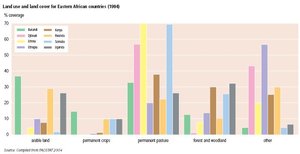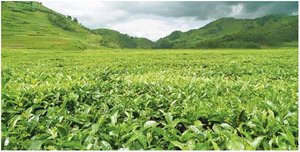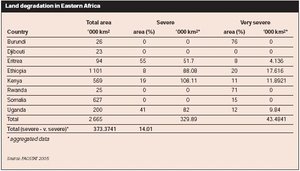Eastern Africa and land resources
Contents
Introduction Figure 1: Actual and potential arable land in countries of Eastern Africa (Source: FAO (Eastern Africa and land resources) and FAOSTAT 2005)
Land is a primary asset for survival and development in Eastern Africa. Land supports the livelihoods of most rural people. Rural population is high: in Rwanda, Ethiopia, Burundi, Eritrea and Uganda more than 80 percent of the people live in rural areas; in Kenya and Somalia more than 60 percent live in rural areas; and, in contrast, in Djibouti only 16.3 percent live in rural areas. Land also provides diverse functions in support of ecosystem processes.
Uganda has the highest proportion of potentially arable land, whereas in Rwanda, all arable land is in use and land pressure is pushing cultivation into marginal areas. In Eritrea, 88 percent is under cultivation. Countries such as Rwanda and Burundi face enormous challenges as they are physically small with high population densities. Burundi’s population density is 265.8 per km2 and Rwanda’s 340.1 per km2. Burundi has the highest rate of deforestation in Africa, and one of the highest globally, with a 9 percent change per year. Potential arable land is negligible in Djibouti because of the extremely arid conditions in the country.
 Figure 2: Land use and land cover for Eastern African Countries, 1994
Figure 2: Land use and land cover for Eastern African Countries, 1994(Source: FAOSTAT 2004)
More than one-third of the land area is covered by permanent pasture and the dominant land use is livestock grazing (Figure 2). About 73 percent of the total area is characterized by desert and dryland conditions, of which significant proportions fall in Djibouti, Eritrea and Somalia.
Though immense, the potential of irrigation is underutilized. The current extent of irrigated land is largest in Somalia. followed by Ethiopia, Kenya and Burundi. In the Horn of Africa, less than 1 percent of the cultivable area is irrigated. In Ethiopia, about 214,720 hectares (ha) is irrigated, while the potentially irrigable land is estimated to be 3,328,910 ha, implying that only 6.5 percent of the potentially irrigable land is currently under irrigation. The area currently under irrigation accounts for about 3 percent of the country’s total food production (Agriculture and development in Africa). In Kenya, potentially irrigable land is estimated to be 540,000 ha, of which 52,000 ha or 9.6 percent of the potential has been developed.
Endowments and opportunities
Agriculture (Agriculture and development in Africa) and tourism are the main drivers of growth in Eastern Africa. Improved agriculture was a key factor in Tanzania’s growth of 6.1 percent and Ethiopia’s growth of 11.6 percent per year.
Land is primarily utilized for agriculture (crop and livestock production), nature-based tourism and extraction of other land-based natural resources such as metal ores and oils. By putting in place appropriate institutional and policy frameworks, and conservation-based agricultural development technologies, the breadth of opportunities to be derived from land can be immense and thus hold great potential for breaking the circle of poverty. Though variable between countries, agriculture accounts for the highest share of gross domestic product (GDP), contributing 51.5 percent in Burundi, 49.9 percent in Ethiopia, 43.1 percent in Uganda and 38.9 percent in Rwanda. For Djibouti, Eritrea and Kenya, the GDP is derived from diverse service sectors.
Integrated land-use planning is an essential tool and defines an approach to land resources management. It introduces mechanisms and incentives for bringing about change in land allocation as well as for identifying suitable biophysical and economic uses, and it prescribes appropriate management practices and options to ensure that land resources are conserved. In Ethiopia, attempts have been made to formulate and implement integrated land-use plans at village, district, regional and national levels. The national land-use plan was based on a nationwide socioeconomic and physical land resources database. There are attempts to implement local or village level integrated land-use planning using watershed or farmer’s service cooperative boundaries as planning units. In Kenya, the watershed management approach has been used extensively to conserve and develop resources at a microlevel.
There are opportunities from agricultural research and technologies which can contribute to development, such as the use of improved seed varieties, agrochemicals and other improved agronomic practices (appropriate planting date, seeding rate, etc). This could result in substantive yield increases, as current production (Agriculture and development in Africa) is often characterized by low input and management levels.
The sustainable use of land resources requires, among other things, a strong institutional framework at all levels. The mushrooming of multiple sub-regional institutions to manage resources, which are of an intercountry nature, is a key element in fostering economic growth (Economic change in Africa). The Intergovernmental Authority on Development (IGAD) was put in place in 1986 with seven member countries including Djibouti, Sudan, Uganda, Kenya, Ethiopia, Eritrea and Somalia, with the aim of strengthening regional cooperation and efforts in areas of food security and environmental protection, maintenance of peace and security and humanitarian affairs, and enhancing economic cooperation and integration of member countries.
 Figure 3: Green tea plantations, Gokeke, Rwanda.
Figure 3: Green tea plantations, Gokeke, Rwanda.(Source: D. Balducci/Still Pictures)
Recurrent drought, limited alternative sources of income, population pressure, limited technology, lack of product diversification and market integration, lack of institutional capacity, environmental degradation and poor access to credit all undermine efficient and sustainable land use. In some countries, including Ethiopia, many interlocking and reinforcing factors including poverty, misguided policies, technological stagnation, population pressure, insecurity of land rights, weak institutional support (credit, extension, etc.), drought and political instability contributed to the stagnation of agriculture (Agriculture and development in Africa), food insecurity and the degradation of natural resources. These factors may make efficient planning and management difficult: in Ethiopia, for example, the effectiveness of the recently launched nationwide agricultural extension program, which embraces about 40 percent of the farming population, has been constrained by high agricultural input prices, shortage of complementary inputs and inadequate extension services. Access to improved technology in Ethiopia is minimal where the average rate of fertilizer (nutrient) application per hectare of cultivated land is 17.5 kg. In Uganda, increased crop and livestock disease, soil degradation, lack of access to improved agricultural inputs, weak agricultural extension systems, inefficient markets, increasing land fragmentation and unreliable weather have been cited as contributing to the declining crop yield of smallholder farmers. On the high and medium potential lands of Kenya, land productivity potential is adversely affected by soil erosion, decline in soil fertility, soil salinization, crop and livestock diseases and fragmentation of landholdings. In the lowlands, where pastoralism is the predominant farming system, a combination of physical, environmental and [[socioeconomic] factors] constrain production efficiency. Gradual resource shrinkage, tenure insecurity and inadequate livestock watering may also be major problems in pastoral areas, as they are in Ethiopia.
 Figure 4: Land degradation in Eastern Africa
Figure 4: Land degradation in Eastern Africa(Source: FAOSTAT 2005)
Land degradation (Land degradation and desertification in Africa) is a serious problem as shown in the table in Figure 4. The total area suffering from severe to very severe degradation is about 14 percent. In particular, Burundi and Rwanda face a serious threat of land degradation, where about 76 and 71 percent of the respective country’s total area encounters very severe degradation problems. They are followed by Eritrea, Uganda, Kenya and Ethiopia, where areas with severe to very severe degradation constitute about 63, 53, 30 and 26 percent respectively of total land area. In Djibouti, wind erosion is the principal form of erosion but is mainly viewed as "natural" due to the absence of agricultural land.
The pressures and driving forces that are attributable to land degradation (Land degradation and desertification in Africa) are similar across the countries of the sub-region. Typical proximate causes include overcultivation, overgrazing and deforestation. The process of soil degradation is affected by poverty, population dynamics, insecure tenure, weak institutional support (e.g., extension, credit, etc.), political instability and factors related to physical land attributes such as topography, soil and rainfall conditions. Topography is an important consideration, as many countries are mountainous. In order of magnitude, Rwanda, Burundi and Ethiopia encounter the highest potential erosion risk due to steep topography.
The areas with the most severe land degradation (Land degradation and desertification in Africa) are also those with the highest population density. The high population density, in the central and northern highlands of Eritrea, Rwanda and Burundi, is an important consideration. Rwanda has the highest population in Africa, with 340 people per km2; its population is growing at 2.1 percent per year. Burundi, with a population density of 265.8, is growing at 3.1 percent per year.
Land tenure is profoundly political, and it continues to be a critical factor in the development of African politics and economies. Land tenure, and in particular ownership and access rights, has been widely recognized to have important bearings on effective, efficient and sustainable management and production regimes. The topography of land tenure varies from country to country and includes freehold tenure, state leasehold and community-based tenure (legally recognized indigenous tenure and community-based). A combination of freehold, state leasehold and community-based tenure prevail in Kenya, Uganda and Rwanda. In Burundi and Djibouti, freehold and community-based tenure, including pastoral systems, occur extensively. In Ethiopia and Eritrea, state leasehold and community-based tenure, including pastoral regimes, dominate. Overall, the tenure situation assessment in most of the sub-region’s countries (Uganda, Somalia, Kenya and Rwanda) reveals that compulsory and systematic tenure conversion to individual ownership offered little benefit to smallholder farmers. In Ethiopia, tenure insecurity is described as being one of the major problems associated with the existing land system. In Kenya, where formal titles to land are held by many farmers, the lack of any significant relationship between land title and crop yield is perhaps explained by the limited use of land titles in obtaining formal credits.
Further reading
- Arsano, Y., 1999. The Predicament of the Ethiopian Pastoralists: Shrinking Resources and Tenure insecurity. Proceedings of the National Workshop on Challenges and Opportunities for Research and Development in Pastoral/Agropastoral Areas of Ethiopia (eds. Mitiku, H., et al.), Mekelle, Ethiopia, 16-18 December 1998.
- Bonger, T., Ayele, G. and Kuma, T., 2004. Agricultural Extension, Adoption and Diffusion in Ethiopia. Research Report I. Ethiopian Development Research Institute, Addis Ababa.
- CSA, 1996. Agricultural Sample Survey 1995/96. Vol. 3. Report on Agricultural Practices. Statistical Bulletin 152. Central Statistical Authority, Addis Ababa.
- ECA, 2005. Economic Report on Africa 2005: Meeting the Challenges of Unemployment and Poverty in Africa. Economic Commission for Africa, Addis Ababa.
- EEA and EEPRI, 2002. A Research Report on Land Tenure and Agricultural Development in Ethiopia. Ethiopian Economic Association and Ethiopian Economic Policy Research Institute.
- FAO, 2005. State of the World’s Forests 2005. Food and Agriculture Organization of the United Nations, Rome.
- FAO/AGL, 2003. TERRASTAT – Land resource potential and constraints statistics at country and regional level.
- FAO and UNEP, 1999. The Future of Our Land: Facing the Challenge. Food and Agriculture Organization of the United Nations and United Nations Environment Programme, Rome.
- FAOSTAT – FAO Statistical Databases. Food and Agriculture Organization of the United Nations.
- FDRE, 2003. The New Coalition for Food Security in Ethiopia: Food Security Programme, Vol. I. Federal Democratic Republic of Ethiopia.
- Gittins, L. and Henricksen, B. L., 1986. Manual of Service Cooperative Consultative Planning. Livestock Development Project, Ministry of Agriculture, Addis Ababa.
- Rahmato, D., 2004. Searching for Tenure Security? The Land System and New Policy Initiatives in Ethiopia. Forum for Social Studies Discussion Paper No. 12. Forum for Social Studies, Addis Ababa.
- Shiferaw, B., 1994. Dual Sector Model Government Intervention and Biases against Agriculture: Theory and Some Evidences from Ethiopia. In Development, Poverty and Environment: Proceedings from a Nordic Course in Development Economics (ed. Holden, S.). Agricultural University of Norway, Aas.
- Sisay, Z., 1999. Water Economy and its Implication on Pastoral Livestock Production. Proceedings of the National Workshop on Challenges and Opportunities for Research and Development in Pastoral/Agropastoral Areas of Ethiopia. Mekelle, Ethiopia, 16-18 December 1998.
- UNEP, 2006. Africa Environment Outlook 2
|
|
| Disclaimer: This article is taken wholly from, or contains information that was originally published by, the United Nations Environment Programme. Topic editors and authors for the Encyclopedia of Earth may have edited its content or added new information. The use of information from the United Nations Environment Programme should not be construed as support for or endorsement by that organization for any new information added by EoE personnel, or for any editing of the original content. |